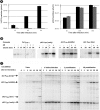Development of giant bacteriophage ϕKZ is independent of the host transcription apparatus
- PMID: 24965474
- PMCID: PMC4178840
- DOI: 10.1128/JVI.01347-14
Development of giant bacteriophage ϕKZ is independent of the host transcription apparatus
Abstract
Pseudomonas aeruginosa bacteriophage ϕKZ is the type representative of the giant phage genus, which is characterized by unusually large virions and genomes. By unraveling the transcriptional map of the ∼ 280-kb ϕKZ genome to single-nucleotide resolution, we combine 369 ϕKZ genes into 134 operons. Early transcription is initiated from highly conserved AT-rich promoters distributed across the ϕKZ genome and located on the same strand of the genome. Early transcription does not require phage or host protein synthesis. Transcription of middle and late genes is dependent on protein synthesis and mediated by poorly conserved middle and late promoters. Unique to ϕKZ is its ability to complete its infection in the absence of bacterial RNA polymerase (RNAP) enzyme activity. We propose that transcription of the ϕKZ genome is performed by the consecutive action of two ϕKZ-encoded, noncanonical multisubunit RNAPs, one of which is packed within the virion, another being the product of early genes. This unique, rifampin-resistant transcriptional machinery is conserved within the diverse giant phage genus.
Importance: The data presented in this paper offer, for the first time, insight into the complex transcriptional scheme of giant bacteriophages. We show that Pseudomonas aeruginosa giant phage ϕKZ is able to infect and lyse its host cell and produce phage progeny in the absence of functional bacterial transcriptional machinery. This unique property can be attributed to two phage-encoded putative RNAP enzymes, which contain very distant homologues of bacterial β and β'-like RNAP subunits.
Copyright © 2014, American Society for Microbiology. All Rights Reserved.
Figures






References
Publication types
MeSH terms
Substances
Grants and funding
LinkOut - more resources
Full Text Sources
Other Literature Sources
Molecular Biology Databases

